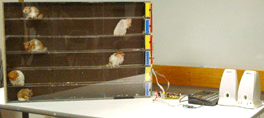
« PREVIOUS ENTRY
Bump. Bump. Bump. Baaaaaa-bump. Bump. Bump. Baaaa …..
NEXT ENTRY »
What hath the Internet wrought?

Levy Lorenzo, a student at Cornell University, has created a MIDI device where the various parts of the song are controlled by hamsters. He describes it on his web site thusly:
Guided by inputs based on hamster movements, Markov chains were used to perform such beat and note computations. In culmination, 3 simultaneous voices were produced spanning 3 octaves and 3 rhythmic tiers. Each voice was controlled by two hamsters: one that was responsible for adjusting the rhythmic qualities of the melody and another that modified the note sequence. With all of these elements in combination, an output was produced with very musical qualities.All of this was implemented using an Atmel Mega32 microcontroller, distance sensors, a HamsterMIDI Controller, and 6 hamsters. Embedded C programming implemented the algorithms and computations within the sequencer.Overall, this project was successful. The control between the hamsters and the musical intelligence turned out very well.
There’s a video of the hamsters playing the music, which may be the most delightful thing I’ve ever seen in my entire life, anywhere. And you know what? The music ain’t half bad! Granted, MIDI being MIDI, it’s not hard to pick a bunch of samples and melodies that inherently sound nice together; in a sense, it seems like the hamsters act mostly as faders, bringing the various constituent parts in and out of play. Either way, I’ve now put an MP3 of this on my main playlist in my player.
(Thanks to Boing Boing for this one!)
I'm Clive Thompson, the author of Smarter Than You Think: How Technology is Changing Our Minds for the Better (Penguin Press). You can order the book now at Amazon, Barnes and Noble, Powells, Indiebound, or through your local bookstore! I'm also a contributing writer for the New York Times Magazine and a columnist for Wired magazine. Email is here or ping me via the antiquated form of AOL IM (pomeranian99).

ECHO
Erik Weissengruber
Vespaboy
Terri Senft
Tom Igoe
El Rey Del Art
Morgan Noel
Maura Johnston
Cori Eckert
Heather Gold
Andrew Hearst
Chris Allbritton
Bret Dawson
Michele Tepper
Sharyn November
Gail Jaitin
Barnaby Marshall
Frankly, I'd Rather Not
The Shifted Librarian
Ryan Bigge
Nick Denton
Howard Sherman's Nuggets
Serial Deviant
Ellen McDermott
Jeff Liu
Marc Kelsey
Chris Shieh
Iron Monkey
Diversions
Rob Toole
Donut Rock City
Ross Judson
Idle Words
J-Walk Blog
The Antic Muse
Tribblescape
Little Things
Jeff Heer
Abstract Dynamics
Snark Market
Plastic Bag
Sensory Impact
Incoming Signals
MemeFirst
MemoryCard
Majikthise
Ludonauts
Boing Boing
Slashdot
Atrios
Smart Mobs
Plastic
Ludology.org
The Feature
Gizmodo
game girl
Mindjack
Techdirt Wireless News
Corante Gaming blog
Corante Social Software blog
ECHO
SciTech Daily
Arts and Letters Daily
Textually.org
BlogPulse
Robots.net
Alan Reiter's Wireless Data Weblog
Brad DeLong
Viral Marketing Blog
Gameblogs
Slashdot Games